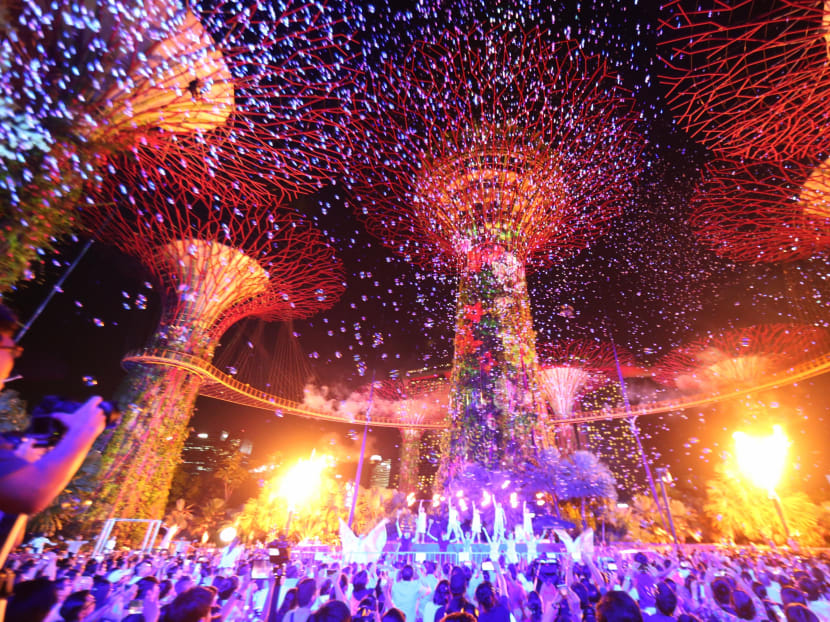Growing a national garden, one plant at a time
SINGAPORE — It is 7pm on a Sunday and Felicia Chua is among some twenty other workers at the Gardens by the Bay who are just starting off the first of 12 consecutive all-night shifts at the Flower Dome.

The Gardens Extravaganza Special is a two-night-only showcase happening on June 3 and 4, 2017. It is the highlight of a weekend of festivities to mark Gardens by the Bay’s fifth-anniversary celebrations. Photo: Ooi Boon Keong/TODAY
SINGAPORE — It is 7pm on a Sunday and Felicia Chua is among some twenty other workers at the Gardens by the Bay who are just starting off the first of 12 consecutive all-night shifts at the Flower Dome.
A short 10-minute brief on what needs to be done, and the small army of workers set off on the hectic and tedious process of tearing down displays and setting up the next one. Chua, 36, together with seven other colleagues lead teams of between three to six, toil across several sections concurrently. Painstakingly, workers remove plants and then carry new ones in, in trays of 50 or so to be placed in new displays at the dome.
The position of every plant matters; from where the types of plants are placed to the set-up of props and the positioning of lights. And every last detail matter. Cables need to be hidden, yet there has to be just enough space for workers to conduct maintenance without stepping on plants.
Once the clock strikes 7am, the team stops work and starts cleaning and tidying the area, ready for the domes to be opened to visitors again at 9am.
The nightly ritual culminates in an elaborate seasonal or themed display — such as the tulip and cherry blossom editions — at the Gardens’ Flower Dome, which would have been a year in planning.
The Gardens by the Bay team, including Chua, usually puts up new displays in the flower dome every two months or so, and has been doing so since it opened its doors in June 2012.
This weekend, Gardens by the Bay celebrates its fifth anniversary. Chua is a senior manager in charge of gardens operations and is among over 350 full-time staff employed by the Gardens today.
Five years ago, the Gardens started with less than half the current staff strength, with 161 employees.
BUILDING A NATIONAL GARDEN
Spanning 101 hectares in the heart of Marina Bay, Gardens by the Bay comprises three waterfront gardens: Bay South, Bay East and Bay Central.
The bold idea to build a national garden on reclaimed land was announced by Prime Minister Lee Hsien Loong during the National Day Rally in 2005.
Two years later, with a development budget of S$1 billion, construction of the Gardens began. Work on Bay South covered landscaping and planting, infrastructure, and associated works such as soil improvement works, drainage system and the provision of key vehicular access roads.
Principal Horticulturalist Anton van der Schans joined the Gardens by the Bay team in 2007 and was heavily involved in the plant selection and design of the gardens.
The Gardens is now home to close to 1.5 million plants of over 5,000 species from all over the world. More than 162,900 plants can be found on the 18 Supertrees alone.
To fit the themes of the different gardens, the 53-year-old Australian — who has an “internal hard drive” of the Gardens — travelled all over the world to “just about every continent except Antarctica” to select plants for the Gardens.
A small number of plants have also been transplanted from parts of Singapore like Anson Road and Tanjong Rhu.
.embed-container { position: relative; padding-bottom: 56.25%; height: 0; overflow: hidden; max-width: 100%; } .embed-container iframe, .embed-container object, .embed-container embed { position: absolute; top: 0; left: 0; width: 100%; height: 100%; }
Because Singapore is close to the equator and has no “significant seasonality”, there have been a few challenges: For example, many plants from other parts of the world sometimes do not flower beautifully due to the absence of “winter stress”.
Therefore, van der Schans and the team had to rely on “a lot of trial and error and experimentation” particularly in the domes.
“Most glasshouses in other botanic gardens are in temperate zones — they use the glasshouse to keep the plants warm during the cold winters; we are doing the opposite. Some plants worked really well for us, and others haven’t been so successful. It’s all part of the fun,” said van der Schans.
Because of that, there are also plenty of opportunities for him to flex his creativity. “One of the most satisfying to me was when we did the Kingfisher lake areas; it had to be planted fast, so I treated it as a revegetation job. We did funny things like leaning some of our saplings over the edge of the water, so the water edges will be shaded, and created a lot of lichens for wildlife.
“It actually worked because we saw a lot of birdlife coming in there and a lot of keen bird watchers there with their big ‘bazooka’ cameras trying to hunt down their birds,” explained van der Schans.
These days, after walking the Gardens’ guard dogs in the morning, you can find van der Schans roaming the grounds until it is “almost dark”, replacing plants and fine-tuning the planting process. Currently, he is busy with the renovation of the World of Plants gardens.
“A few years ago, we were getting to a stage where we weren’t bringing huge volumes of plants any more... The Gardens is getting very full now and we don’t have a lot of space... We planted things in a hurry to get the gardens open and looking great and now it’s time to take stock and work out how we can improve,” said van der Schans.
CHALLENGES IN THE EARLY DAYS
Getting the Gardens to what it is today has not been all smooth-sailing. Building on reclaimed land, for example, meant that costly preparation work had to be done “underneath the surface” before the planting process could start.
“(There’s) the engineering work, huge amount of piling and drainage work; then we have to create a whole new soil profile, and we actually changed the levels of the land to develop the gardens,” said van der Schans.
Chua also pointed out they faced two major issues: Excessive water log and the sinking of the land.

“(Soil on reclaimed land) can’t drain as well as loose soil... Certain parts will keep sinking so we have to keep doing maintenance, like the concrete might crack due to sinkage and we have to top it up with cement,” she explained.
But despite the early challenges, both van der Schans and Chua said it was gratifying to be part of the team that has grown the Gardens “from nothing”.
“It is really awesome to see from a piece of bare land with just sand flying in your face to what it is now, and visitors really appreciating and feeling that the Gardens is a national pride for them,” said Chua.
HORTICULTURAL-THEMED ATTRACTION
As of May this year, the Gardens has welcomed more than 33 million visitors.
It is home to key attractions like the Flower Dome, the Cloud Forest, and the Supertree Grove. New highlights that have opened over the five years include the Far East Organisation Children’s Garden, the outdoor cactus garden Sun Pavilion, the Floral Clock and rock garden The Canyon.
“Gardens by the Bay is not positioned as a traditional garden. Instead, we consider ourselves a horticultural-themed attraction, and we serve a different purpose from botanical gardens around the world,” said Felix Loh, 48, Chief Operating Officer at the Gardens by the Bay.
.embed-container { position: relative; padding-bottom: 56.25%; height: 0; overflow: hidden; max-width: 100%; } .embed-container iframe, .embed-container object, .embed-container embed { position: absolute; top: 0; left: 0; width: 100%; height: 100%; }
More than 1,000 events have taken place, including the popular music festival St Jerome Laneway Festival, Sundown Marathon and the annual Children’s Festival.
“As an attraction, we have tried to reach out to a broad audience beyond just nature lovers. Gardens by the Bay has diverse offerings that range from unique floral displays showcasing temperate plants that are not commonly seen in the region, to myriad events and activities throughout the year,” said Loh.
Since its opening, the Gardens have also grown to become a feature of national pride that has found a place in the hearts of many Singaporeans.
One family, in particular, has spent so much time at the Gardens, it has also formed part of familial history.
Growing up, the Yeo siblings aged 18, 16 and 14, began visiting the Gardens with their parents. They visited “at least 10 times over six months”, they said. So much so, the eldest, Zuoheng, decided to start volunteering at the Gardens in 2013.
The second brother, Zuosheng, 16, said: “It’s mainly family time (to us). It’s a treat for us whenever we come here, to get off from stress.”
The two brothers and their younger sister Limin, 14, head to the Gardens together “80 per cent of the time” to do outdoor gardening twice a month on Saturdays.
The volunteers have also formed a close-knit “extended family” among themselves. But the Yeo siblings say, they wish more youths would step forward to help at the Gardens.
“(We) are the three youngest here. We want more youths to come join us, because we are quite lonely here, though we get doted on,” said Limin.
.embed-container { position: relative; padding-bottom: 56.25%; height: 0; overflow: hidden; max-width: 100%; } .embed-container iframe, .embed-container object, .embed-container embed { position: absolute; top: 0; left: 0; width: 100%; height: 100%; }
THE FUTURE
Now that it has reached its first milestone, the team at Gardens by the Bay has its sights set on the next lap.
Moving forward, Loh said, there is room to explore how the Gardens can leverage on new technologies such as virtual or augmented realities, to enhance their current offerings.
“In today’s highly wired world, where many are often alienated from nature, Gardens by the Bay seeks to re-connect people with plants in a way that they can relate to, and reach out to an urban generation living in a digital age,” he said.
One of the Gardens’ longest serving employees, Andy Kwek, 45, Director of Conservatory Operations and Engineering who joined in 2005, expressed hope for Gardens by the Bay to become internationally recognised.
“I hope that five years on, all our efforts would make Gardens by the Bay as internationally-renowned as the Eiffel Tower or Grand Canyon. Mention “Gardens by the Bay”, and people the world over will know what it is,” said Kwek.
Loh agreed, adding that “what drives us has not changed since day one: To be a world-class attraction”. “We must continue to work hard to keep our offerings fresh to surprise and delight our visitors.”
But at the heart of the Gardens’ desire, Loh said, is for the Gardens to be “a national icon loved and cherished by every Singaporean”.
.embed-container { position: relative; padding-bottom: 56.25%; height: 0; overflow: hidden; max-width: 100%; } .embed-container iframe, .embed-container object, .embed-container embed { position: absolute; top: 0; left: 0; width: 100%; height: 100%; }
The Gardens Extravaganza Special is a two-night-only showcase happening on June 3 and 4, 2017, and is the highlight of a weekend of festivities to mark Gardens by the Bay’s fifth-anniversary celebrations where aerial performers and dancers perform against a backdrop of video mapping on the Supertrees.






